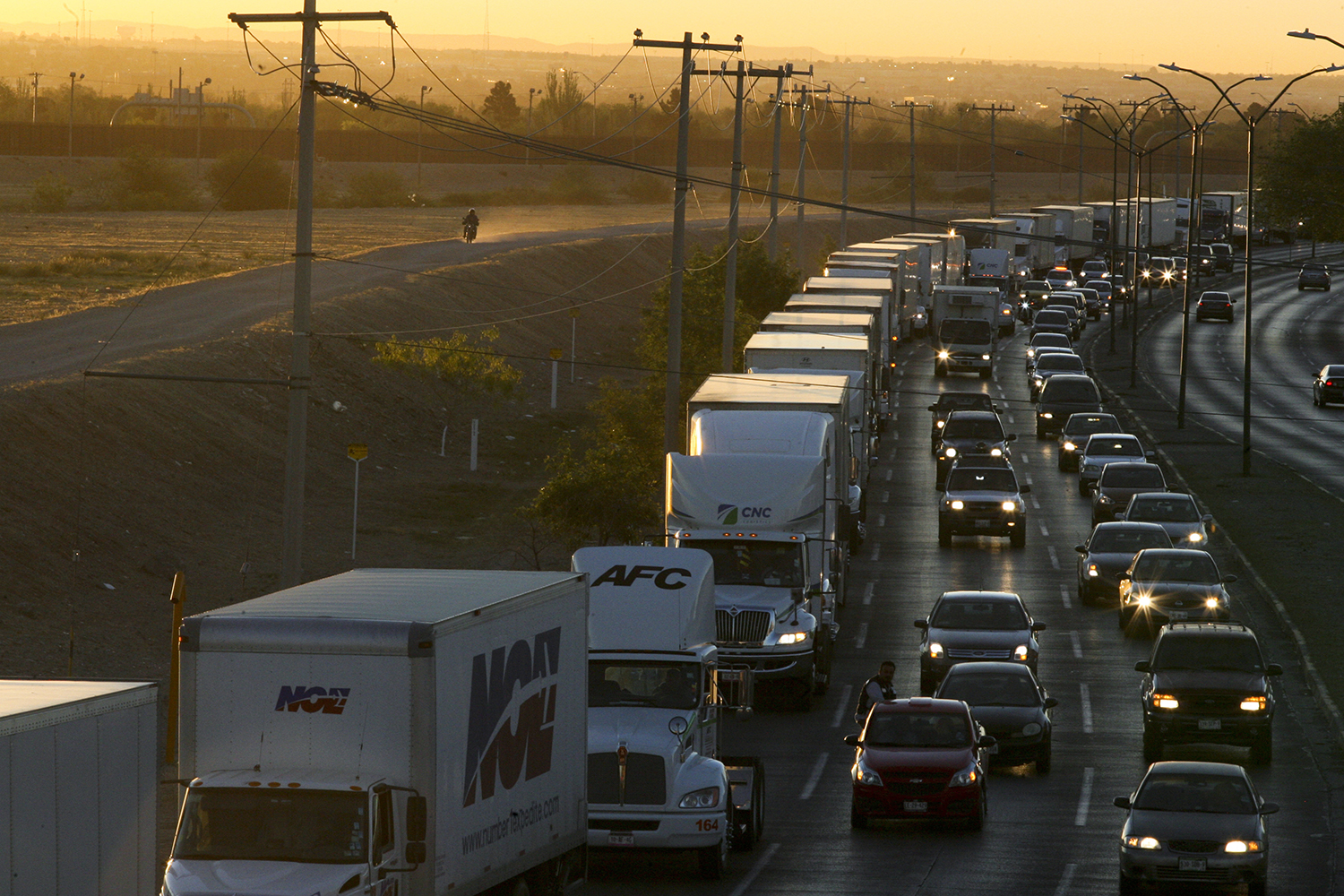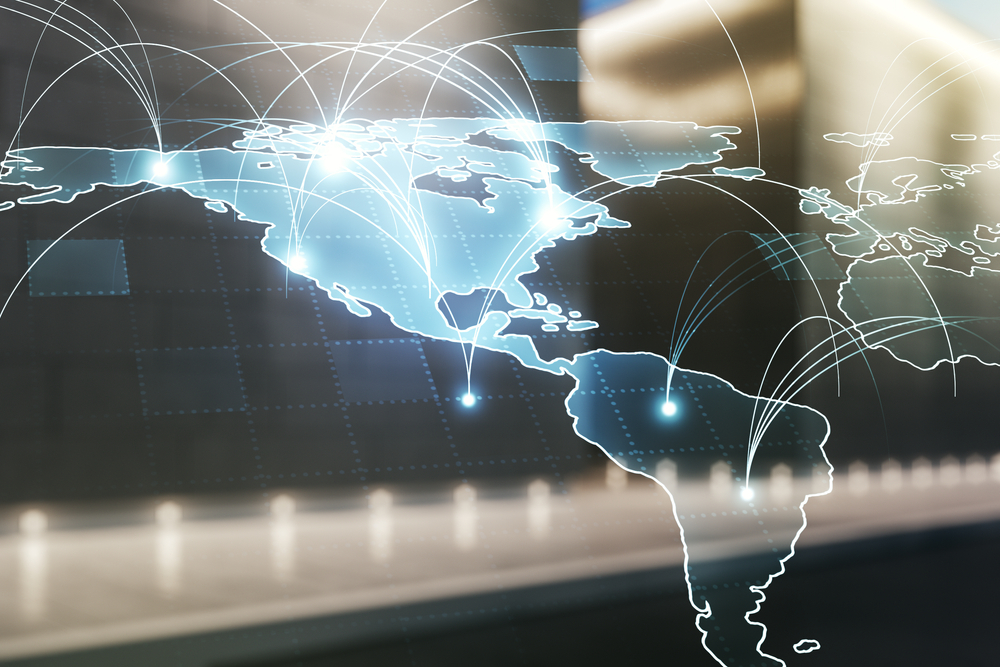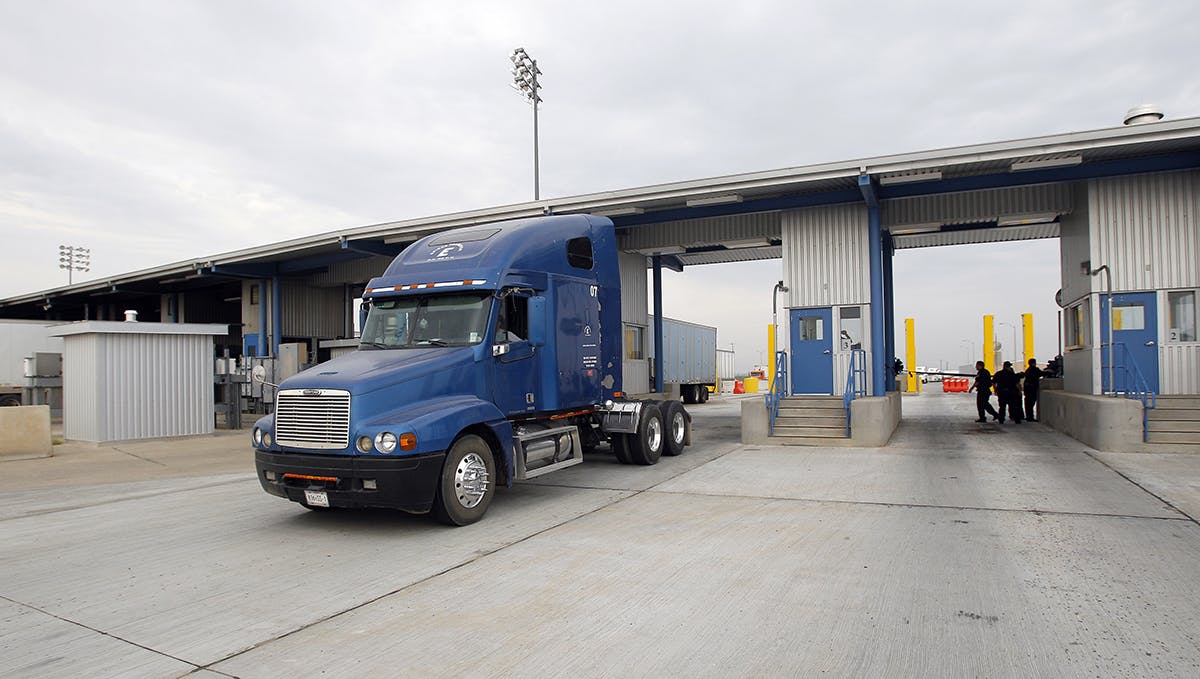Winter 2023
A Living Lab at the Southern Border
– Daniel Covarrubias and Gaston Cedillo
How “logistechs” technology can improve US-Mexico trade and competitiveness.
The Fourth Industrial Revolution, also known as Industry 4.0, is changing how businesses operate and the environments where they compete. This new industrial revolution highlights the use of exponential technologies such as blockchain, cybersecurity, data analytics, artificial intelligence, augmented and virtual reality, and the internet of things—physical objects that connect and exchange data with each other over the internet. Industry 4.0 advances the convergence and integration of these digital-based technologies in designing new industrial and supply chain models capable of competing both in flexibility and cost. This accelerated convergence effect is the main reason exponential technologies will have a significant impact on our lives. It occurs when these various technologies grow exponentially, and their growth curves begin to intertwine. These interactions are what allow us to race toward the digital transition.
“Logistechs” is a concept that has emerged from Industry 4.0. It refers to new advances in the industrial sector where exponential technologies play a crucial role. We define logistechs as the impact that exponential technologies have on logistics. We classify them as the exponential technologies that support the transport of goods, that improve their handling, and that expedite their customs clearances. Logistechs optimize the processes involved across the supply chain, from demand forecasting to route planning. The goal of logistechs is to achieve greater efficiency and raise the level of customer satisfaction.
Major ports of entry have seen exponential increases through the last 10 years, with Laredo—the most important land port for commercial vehicles—seeing a 60 percent increase in traffic.
However, the current lack of “end-to-end” supply chain cybersecurity, visibility, information traceability, and transparency lead to public and private discoordination, increasing logistics costs, and decreased supply chain resilience. Speed, competitiveness, productivity, and timing have always been essential in logistics. Today, as supply chains become increasingly complex, with more participants, there are endless documents to verify and lengthy processes to follow. Exponential technologies are vital in handling, treating, and analyzing information, and in managing physical processes. These advances translate into continuous improvement of supply chains. Robots, autonomous vehicles, and the automation of paperwork verification will eliminate the simple and repetitive work scattered throughout logistics processes, leading to a higher quality of service. Big data analytics and artificial intelligence, or AI, will allow companies to analyze their customers’ past transactions and shipments, forecast highly accurate demand, and adjust their warehouse spaces and personnel to reduce time-to-market and costs. Cloud computing and machine learning can aid in materials classification, valuation, and tariff compliance. Blockchain has the potential to give businesses and port authorities the global shipment visibility that will improve tracking and compliance in secure, real-time shared ledgers. These digital ledgers can generate total linkages between manifests and invoices, allowing for the supervision of the entire logistics process and data sharing across multiple customs organizations and users.
While the trading world is segmenting into regional markets derived from nearshoring practices, supply chains require less variability in cross-border crossing times to be competitive. Land ports of entry refer to the facilities through which entries or departures, both to and from the United States, of people, vehicles, cargo, and materials occur in a controlled and supervised manner by US Customs and Border Protection, or CBP, and other federal inspection agencies. As such, they are a critical link connecting trade flows stemming from the United States–Mexico–Canada Agreement (USMCA) and are the cornerstones of North America's current and future competitiveness. To improve the effectiveness of supply chains in the USMCA region, land ports of entry must transition from their current state of administrative stopping points to collaborative, binational innovative spaces that will make processes more fluid for cross-border freight flows.
Growing Activity Does Not Grow Efficiency
According to the US General Services Administration, there are 167 land ports of entry on the United States' borders with Canada and Mexico. Data compiled by the Texas Center for Border Economic and Enterprise Development show that $1 trillion in trade, over 130 million people, 62 million cars, 12.5 million commercial trucks, and 3.5 million railroad cars are processed annually through the United States’ land ports at its southern and northern borders.
Data can be analyzed, helping produce higher efficiency, speed, throughput, and quality in border crossings.
A significant amount of activity occurs daily at these ports. The Texas Center for Border Economic and Enterprise Development data shows us that annually, in Laredo alone, $250 billion in trade, 7.8 million people, 3 million passenger vehicles, 2.5 million commercial trucks, and 500,000 railroad cars are processed. That’s trade equivalent to about $770 per person in the US, and twice the population of Oklahoma coming through one Texas town. Major ports of entry have seen exponential increases through the last 10 years, with Laredo—the most important land port for commercial vehicles—seeing a 60 percent increase in traffic. San Ysidro, a port of entry near San Diego, and the most crucial land crossing for passenger vehicles, is experiencing an increase of about 15 percent. The Eagle Pass entry port in Texas has seen an increase in loaded train containers of 93 percent in the past 10 years.

Regrettably, this exponential growth does not always correlate with keeping up with the latest technologies. Two of the big four consulting firms—McKinsey & Company and Deloitte—have identified several challenges for land ports: the increasing complexity of operations, increased pressure for improved security and faster processing, slower adoption of automation versus comparable sectors, and transformation into environmentally cleaner and more efficient facilities. Smart infrastructure, innovation, and technological development will shape the land ports of the future, and help them to solve these challenges.
Digitalization, automation, technological advances, cybersecurity, data access, and environmental awareness are changing how we securely move cargo and people across borders. However, one question arises: since the volume and type of products crossing are different at every land port of entry, which is the right technology for improving the local operational conditions of every port?
A Living Lab
Cross-border supply chains involve multiple stakeholders in a complex and dynamic logistics environment. It is challenging to define only one standardized solution that fits it all. Our experience in designing technological solutions for the logistics and transportation sector has taught us that a solution for one issue could result in a problem for another. In these contexts and environments, we have found it helpful to apply a living lab approach for testing innovative technologies and solutions.
The concept of living labs is credited to William J. Mitchell of MIT, who in early 2003 proposed to move research and development to "real-life" conditions. In the cross-border environment, the living lab approach provides a formal framework to deliver action-driven solutions fostering technology deployment and improving interactions between various cross-border collaborators. The living lab concept fits very well with what is needed to solve the complexities of cross-border freight flows.
Blockchain—together with AI, big data, and predictive analytics—can reshape customs clearance processes at ports of entry.
In this context, higher education institutions are fundamental players in favoring collaborative learning, which is needed to innovate. Their education curricula shape regions, and their engagement with the private and public sectors make them essential for designing innovative solutions. For example, Texas A&M International University, or TAMIU, recently developed its own Logistechs Living Lab with the express purpose of establishing pilot programs that realize concrete innovations for logistics solutions.

TAMIU’s Logistechs Living Lab incorporates all the main stakeholders—especially tech users—throughout each phase of the pilot project. At the same time, it provides a measurement system to monitor and evaluate technological solutions, which are defined by the participants to solve their needs and reach their operational objectives. Let us use the framework of logistechs to analyze the impact of some technologies on improving freight flows moving through a port of entry.
Technology and Trade Flows
Considering international trade and cross-border transportation, three leading exponential technologies can produce significant efficiencies: autonomous vehicles, the internet of things and data analytics, and blockchain.
Autonomous or driverless vehicles have the potential to reduce adverse environmental effects and raise safety standards. They increase transport efficiency because they aren’t tied to a human driver’s need for breaks. They also autonomously move goods between land port facilities and across international borders, allowing for a complete security screening process. Land ports of entry demand an efficient network of people, computers, and devices, working together to securely clear cargo and people, and to avoid delays.

The internet of things—for example, sensors—permits data to be gathered about transportation and traffic patterns of people, passengers, commercial vehicles, and railroad cars. These data can then be analyzed, helping produce higher efficiency, speed, throughput, and quality in border crossings. Thus, technologies such as artificial intelligence, or AI, predictive analytics, robotics, and automation could be implemented to reduce the handling costs associated with inspections at ports of entry. As a result, optimization models can be generated using predictive analytics and AI to minimize border crossing wait times, while at the same time increasing screening and security capabilities at ports. Automation and AI enable port security agencies to evaluate travelers and cargo using intelligent sensors that integrate technological advancements in traveler and cargo processing. The use of biometric screening and nonintrusive inspection devices aid agencies in detecting security hazards. Machine-learning algorithms can better anticipate threats and program resources as needed.
Finally, blockchain—together with AI, big data, and predictive analytics—can reshape customs clearance processes at ports of entry. Blockchain increases the traceability of materials within supply chains, improves visibility and compliance, and reduces paperwork and administrative costs by reducing physical inspections. It gives businesses and port authorities global shipment visibility, generating a total linkage between manifests and invoices, allowing for the supervision of the entire logistics process, and for data sharing across multiple customs organizations and users. This exponential technology enhances collaboration between government agencies and corporate entities, expanding opportunities to work jointly to meet new security and efficiency challenges.
Let's take a closer look at blockchain technology.
The US imports more auto parts from Mexico than any other country. They start at the manufacturing plant—or before, if you take into account raw materials and other components that go into auto parts. They are stored in a warehouse, then loaded onto a truck, then they cross the border and make their way across various state lines. They might be stored in another warehouse until they are loaded onto another truck, then delivered to your local auto parts store. Each move involves different companies, following Mexican and US laws and regulations, governed by complex trade agreements between the two countries. In short, there are a lot of places where things can go wrong.

Blockchain uses digital tokens to track each movement in the supply chain. It is a distributed ledger system that, in this example, can provide a secure, transparent way for officials of US Customs and Border Patrol (CBP) and the Agencia Nacional de Aduanas de Mexico—CBP’s Mexican counterpart—to track the detailed movements of auto parts across the border. Logistics partners—from the manufacturer to the shipper, freight handler, and final client—can use blockchain technology to create a digital record of the parts as they move along the supply chain in real time from Mexico to the US and vice versa. CBP can then use this log to have complete visibility, and traceability, to corroborate the genuineness of the auto parts and ensure that they meet all the necessary regulatory requirements, protecting both governments and consumers.
Think of these blockchain digital tokens as smart contracts that can expedite the clearance process, make it self-executed, and do it in real time, ensuring that the parts are cleared promptly and can be delivered to the end user, making the whole process more efficient. Now imagine blockchain technology deployed for mineral fuels, machinery, and agricultural products—or any of the main imports and exports between the two countries.
Many of these supply chains—particularly those for automotive parts and agricultural products—work on just-in-time mechanisms where any delay can have an impact on production targets or shelf life. In both cases, the financial impact is significant.
When you consider the effect that the three leading technologies could have on just one product, the potential is staggering. But technology is implemented by people.
The Need for Adequately Trained People
Another essential aspect of Texas A&M International University’s Logistechs Living Lab is human resource skills. Today, it is clear that even though technology is an increasing part of supply chains, the effectiveness of cross-border logistics technology is extensively linked to adequately trained people. The logistics performance of organizations, industries, and nations is increasingly influenced by the quantity and quality of logistics technologies, but also by the logistics professionals who use these technologies. Poor-quality training and inadequate knowledge about logistics technologies hinder the performance of complex cross-border processes, obstructing USMCA’s regional competitiveness.
Because of mainstream logistics’ intense connection with various economic sectors, the lack of logistics technologies and the associated lack of talent reduce companies’ effectiveness and, by extension, the economic productivity of USMCA countries. A logistechs living lab that makes interactions between logistics professionals and exponential technologies easier would increase regional abilities to develop more resilient and less polluting supply chains and, by doing this, positively change the future of trade between the US and Mexico, and make both countries more economically competitive.
Daniel Covarrubias is the director of the Texas Center for Economic and Enterprise Development at the Texas A&M International University (TAMIU) A. R. Sanchez Jr. School of Business, home of the TAMIU Losgistechs Living Lab. He received a PhD in business competitiveness and economic development from the Deusto Business School in Spain, a master of arts in political science from TAMIU, an MBA from the University of Texas at San Antonio, and a bachelor in business administration from Monterrey Tec. He sits on the Standing Committee on International Trade and Transportation of the National Academies of Sciences, Engineering, and Medicine’s Transportation Research Board (TRB), the US Customs and Border Protection Commercial Customs Operations Advisory Committee’s Working Group on Cross-Border Recognition, and the US-Mexico Foundation C26+ Smart Borders Working Group. His research centers on cross-border regional development, regional innovation systems, and logistechs.
Gastón Cedillo-Campos is a logistics system dynamics specialist. For more than 15 years, he has been an academic researcher and consultant for public agencies and multinational companies. He received a doctorate in transportation and logistics systems from the University of Paris. He is a member of the Texas Center for Border Economic and Enterprise Development of Texas A&M International University, and a founder of the National Laboratory for Transportation Systems and Logistics of the Mexican Institute of Transportation and the Mexican Logistics and Supply Chain Association. He is the scientific chairman of the International Logistics and Supply Chain Congress. He has designed several real-world projects, including the first urban logistics living lab in Latin America, a real-life laboratory for measuring logistics practices, transportation emissions, and energy in “Last-Mile” deliveries; eraclituX, an interactive digital map that uses extensive GPS data to measure the reliability of travel times on freight transportation corridors in Mexico; and IMT-X, an autonomous, unmanned aerial vehicle for logistics purposes.
Cover photo: A Customs and Border Protection officer watches as a car moves through a large scanning device during a secondary inspection at the San Ysidro port of entry in San Diego. AP/Gregory Bull.
